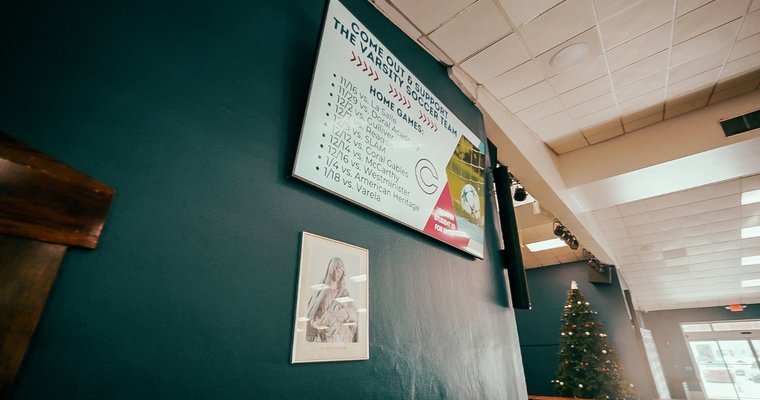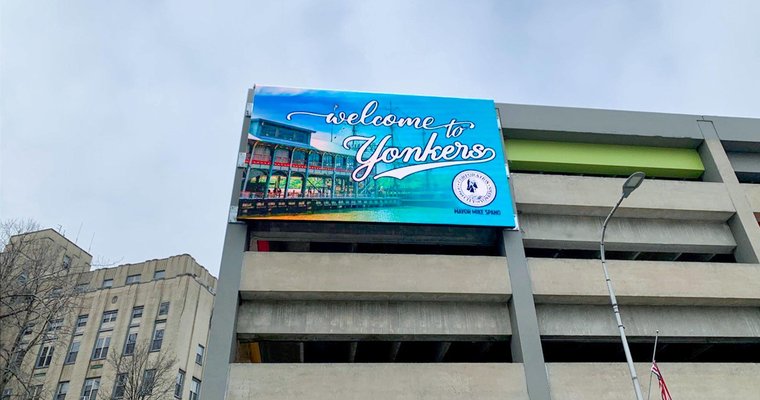
[ad_1]
Alex Seage, director of technology and innovation at Christopher Columbus High School in Miami, Florida, shared how he helped lead a digital transformation on the campus in part thanks to his perspective as a newcomer to the education sector.
 Image provided by Merritt Group.
Image provided by Merritt Group.
 |
Alexander Seage. Image provided by Merritt Group. |
Not many high school IT staff get their start in cruise line IT and digital signage like Alex Seage, but he says it prepared him for dealing with students. After all, Seage quipped, there is not too much of a difference between rambunctious cruise ship passengers after a few margaritas and the average rowdy high schooler.
Now serving as senior director of technology and innovation at Christopher Columbus High School in Miami, Florida, Seage explains the power of digital signage in the education space, a growing area for the digital signage industry.
Seage says his eclectic background gives him an edge in supporting digital signage in schools, where not many have knowledge and experience in signage. “As a consumer day to day, you see digital signage every day, you just don’t know it’s called digital signage,” he said. As an outsider, he was able to bring a fresh perspective.
“Schools for the most part, what I noticed coming from the outside was, well, most people who work in a school, they’re there for quite a while. They often don’t know what’s actually out there beyond the four walls of their own school. So they never had digital signage, they don’t know what that means.”
 |
Image provided by Merritt Group. |
When he first started his job, he said there was no unified system. There were televisions placed at random locations around the campus in metal boxes with plexiglass to prevent students from damaging the screens, along with a few televisions with DirectTV boxes plugged into them, and several completely unused, unpowered units in the cafeteria. “They were used for digital signage,” Seage said of the models that were formerly used as digital signage. “But it was more like they loaded PowerPoint on a USB and updated once a year.”
This environment provided an opportunity for Seage to combine his knowledge with his passion as an innovator, especially because his school system is private, which allows it to make more agile changes than may be possible in some public school systems.
A digital transformation was in order, and Seage started with a unified visual communication system (or digital canvas) with a unified software system. Everywhere on campus has a screen within eyesight, Seage said, which is partly informational and partly for safety, along with pushing school content like sports matches.
Unlike some school systems, Seage says he didn’t face as much skepticism or resistance as one might expect. Teachers were already using digital whiteboards, so they understood some of the technology already.
Replacing the displays with a uniform, pro-grade model and brand (instead of consumer-grade models from various brands) was one of his first goals.
 |
Image provided by Merritt Group. |
This allowed the displays to become dual-purpose: using Magic Info, the televisions are smart displays, so users can watch television in addition to the digital signage, along with the school being a Mac school, which allowed lots of airplay sharing for presentations and collaborations on the campus.
In a conference room used for hybrid meetings, Seage said putting an Apple TV in allowed the space to easily become multipurpose. “It really was a bigger picture,” he said of the transformation project. “We never went through and like said hey, let’s just do digital signage, and this is the ROI… Okay, digital signage is a piece of a unified system, and that’s the backbone.”
What about content? A marketing director originally put together a slideshow, but when a new manager started, the school started designing digital content. From social media to alumni information. The student activities manager is now the content manager for things like school events and school announcements, which dominates the content, along with moderating any student content submissions.
How can schools choose software, hardware? “The first thing that’s important to know is, the price of displays has come down tremendously,” Seage said. Folks in education often don’t understand the difference between consumer grade televisions (with much lower durability and features) and enterprise ones.
For the displays, Seage’s team chose Samsung displays. Every display is Samsung, from computer monitors or television displays for live TV or classroom displays.
 |
Image provided by Merritt Group. |
Previously, the digital touch boards that the school had presented issues with lag and other issues the teachers complained about frequently; the classroom displays seemed not to have been built in an enterprise or education-focused way, instead acting more like little more than a digital chalkboard. By contrast, Samsung’s purpose-built displays changed the game, Seage said.
“I think that’s where Samsung’s display technology and then building a display that’s touch screen that works for a classroom was beneficial. I think they did it right, they came from the tv world into the classroom instead of building from a traditional classroom to a digital display.”
Seage estimates about 60% of the teachers have learned to stop teaching from the front of the classroom, using the new technology to engage the full classroom thanks to wireless connectivity to iPads, allowing instructors to walk freely around the classroom and collaborate with every student. Students can also collaborate using this wireless technology without having to walk to the front of the classroom; they can use airplay functionality to simply work from their desk. This is device-agnostic, so students can use Apple, Android and other devices, especially with the option for wired connections like HDMI.
Ultimate flexibility is at the core of digital transformation in classrooms, Seage argues, along with futureproofing through good design, planning and investing in enterprise-grade hardware.
Seage says there are two factors in the research for engaging students: content and room layout. The traditional portrait layout makes kids at the back feel less involved, he explained, but the new method engages every student with a landscape layout. The middle of the class is open for the teacher to walk around, which also helps the students stay on task and pay attention.
One caveat is that this is an independent school, Seage said; so, while he advocates for the power of his methods, there are schools and districts with more limitations on funding, policy and so forth.
“I’d say the biggest thing was just exposure — I don’t think that everyone is aware of what’s out there and how you can accomplish it, and if you make a step-by-step plan … it’s much easier to accomplish and much cheaper than you think, and the ROI is just way greater than you can imagine.”
Daniel Brown is the editor of Digital Signage Today. He is an accomplished technology writer whose experience includes creating knowledge base content for a major university’s computing services department. His previous experience also includes IT project management, technical support and education. He can usually be found in a coffee shop near a large pile of books.
[ad_2]
Source link






